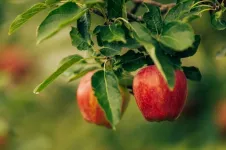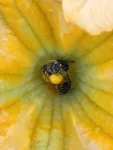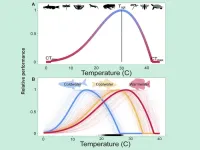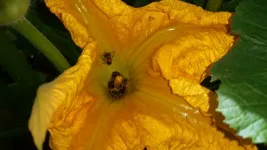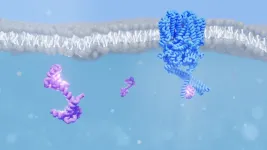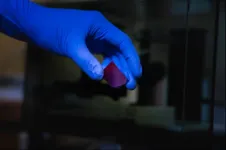(Press-News.org) As the old English proverb goes, “An apple a day keeps the doctor away.”
It’s long been known that apples offer multiple health benefits. Rich in fiber and antioxidants, they are linked to a lower risk of many chronic conditions, including diabetes, heart disease, and cancer.
And while apples help protect human health, what is being done to protect the health of this delicious and nutritious fruit?
Researchers at the Alson H. Smith Jr. Agricultural and Extension Research Center, a Virginia Tech facility in Winchester well-known for its contributions to the commercial fruit industry, are studying methods to fight fire blight, a contagious and often deadly disease that affects apples and other pome fruits, such as Asian pears.
In the past 15 years, more frequent warm and wet weather during the spring has sparked epidemics of fire blight, causing losses of up to $22 million per year in apple and pear crops. Particularly impacted regions include the mid-Atlantic, northeast, and Pacific northwest.
With funding from two grants by the United States Department of Agriculture estimated at a total of more than $360,000, Srdjan Acimovic, an assistant professor in the College of Agriculture and Life Sciences’ School of Plant and Environmental Sciences, is developing new effective treatments for fire blight — more specifically, fire blight bacterium Erwinia amylovora in fire blight cankers. Cankers are infected dead zones on wood bark and often cause up to 50 percent of losses of orchard acreage.
“This project will provide growers with critically-needed, next-generation control options for all fire blight phases – cankers, blossom blight, and shoot blight,” Acimovic said.
In the past 15 years, more frequent warm and wet weather during the spring has sparked epidemics of fire blight, causing losses of up to $22 million per year in apple and pear crops. Particularly impacted regions include the mid-Atlantic, northeast, and Pacific northwest. Photo courtesy of Srdjan Acimovic.
Stopping the spread
Fire blight, like so many diseases that affect plants and humans, is complicated to manage. Discovered in the early 1800s, it is the first-ever described bacterial plant pathogen in the history of plant pathology. The disease remains a challenge for today’s researchers because of many factors, including climate change, the way fruit trees are now commonly planted, and the disease’s ability to spread quickly, and often, secretly.
Historically, growers planted fruit trees far apart on large acreages of land — 200 to 300 trees per acre. Trees would grow tall and sprawling and require a ladder and a lot of labor to harvest. Today, most growers plant high-density apple orchard — 1,000 to 2,000 trees per acre — with smaller trees planted closer together.
“The reason why they do this is because it's lucrative and they can produce much more fruit per acre,” Acimovic said. “But at the same time, if proper control practices are not applied timely, this allows fire blight to spread more easily. Flowers eventually develop on the trees, and that's where the entry point for fire blight is.”
Fire blight thrives in warm, wet conditions and starts appearing during the correlating spring months. The continual mix of rain and sun allows the bacterium to infect the flowers, resulting in blossom blight.
The infection doesn’t stop there. It spreads into the shoots – resulting in shoot blight. Eventually, the bacterium invades the wood tissue and trunk of the plant, causing cankers. Cankers harbor deadly bacteria that can hibernate during the winter months, a process called overwintering, and spread in the spring to new flowers. They can, and often do, lead to the death of trees, resulting in profit loss and a fear that other trees will, too, be infected.
Acimovic has seen firsthand fire blight’s devastation. He is stationed at the Alson H. Smith Jr. Agricultural Research and Extension Center, where many of the facility’s apple trees used for research have succumbed to the disease.
“It looks like someone has taken a blowtorch to them,” he said.
Traditional treatment of fire blight begins in the spring. Growers spray the trees with copper-based pesticides as a general sanitation measure. The spray may disinfect the surface of the branches and cankers, but bacteria can remain dormant inside.
And that’s where Acimovic’s research begins.
“No matter how well the growers prune the orchards to take cankers out, there will always be enough cankers remaining in the orchard to allow the bacterium to overwinter and potentially infect again the flowers in the spring,” he said. “What I want to do with this research is develop new spray management options that target the bacterium inside of the bark of the cankers and target this stage that has been very poorly investigated in the past.”
To support this research, the U.S .Department of Agriculture (USDA) awarded Acimovic, the principal investigator, and his team of researchers at University of Virginia and Oregon State University, a $75,000 USDA Specialty Crop Block Grant and a $287,000 USDA-NIFA Crop Protection and Pest Management Grant.
The grants will fund two similar projects with goals to develop effective dormant copper spray treatments in a mix with bark penetrating oils for eradication of fire blight bacterium Erwinia amylovora in fire blight cankers, evaluate spray programs with different plant activators that prevent shoot blight and fire blight cankers, and test newly designed antimicrobial enzymes that degrade biofilm of the bacterium to control blossom and shoot blight.
Acimovic is using an advanced and novel approach to learn more about the bacteria that harbors inside the cankers, the focus of his research to combat fire blight.
The technology is called Droplet Digital (dd) PCR (Polymerase Chain Reaction). Its more common counterpart is Digital (d) PCR. Both tools help amplify, or detect, if a pathogen is present. Similar technology was used to detect SARS-Cov-2 and its different variants during the COVID-19 pandemic.
In fire blight’s case, DNA is extracted from a sample of a canker and processed through PCR machines. With a digital PCR, a chip reader machine detects small “fingerprint” regions of DNA molecule specific to Erwinia amylovora. If the fire blight pathogen is present, the machine reads as blue dots. Yellow dots mean negative or no detection. The machine can also selectively quantify only the live cells of this pathogen, or determine how much of the bacteria is present in a canker.
Droplet digital PRC is similar but superior technology, Acimovic said. Microscopic droplets of oil mix with the DNA of the plant and the pathogen. Should a pathogen be detected, the droplet emits fluorescent light read by the reader. This method can detect very low amounts of the pathogen, even more than the digital PCR, leading to higher sensitivity of detection and accuracy.
“This is the latest technology, and we have made many more advances with this research in my lab,” Acimovic said. “We are excited to continue this revolutionary study that we hope will soon benefit our industry partners and stakeholders across the commonwealth.”
END
Virginia Tech researchers fight fire blight’s plight on apple production
2023-04-03
ELSE PRESS RELEASES FROM THIS DATE:
Huddersfield Business School awarded coveted AACSB Accreditation
2023-04-03
Huddersfield Business School has been awarded a coveted accreditation which less than six percent of institutions offering business degree programmes manage to achieve and is a result of ‘its dedication not only to the students, alumni network, and greater business community, but to the higher education industry as a whole’.
AACSB accreditation from AACSB International ensures continuous improvement and provides focus for schools to deliver on their mission, innovate, and drive impact. The accreditation was led by Huddersfield Business School’s former Dean Professor Jill Johnes who retired at the end of January ...
Galaxy clusters yield new evidence for standard model of cosmology
2023-04-03
Cosmologists have found new evidence for the standard model of cosmology – this time, using data on the structure of galaxy clusters.
In a recent study, a team led by physicists at the Department of Energy's SLAC National Accelerator Laboratory and Stanford University made detailed measurements of the X-ray emission from galaxy clusters, which revealed the distribution of matter within them. In turn, the data helped the scientists test the prevailing theory of the structure and evolution of the universe, known as Lambda-CDM.
Getting there wasn’t an easy task, however.
Here's ...
New UH project combats food insecurity through AI
2023-04-03
One in eight Texans experiences food insecurity, according to the non-profit agency Feeding America. That means 1.4 million Texas households are food insecure, with limited or inconsistent access to nutritious food for an active, healthy life. The USDA's most recent survey on the issue reported that Texas is among the top nine U.S. states with a higher prevalence of food insecurity than the national average.
To address this issue, a University of Houston-led team is developing an artificial intelligence-based platform that can support the food charity ecosystem through data-driven technologies.
"The commitment of our team is to help our fellow ...
Generosity is left-wing
2023-04-03
Is the tendency to share with other people linked to political orientation? And in which way? In a new study, researchers from the IMT School for Advanced Studies Lucca, Ca’ Foscari University of Venice, and University of Milan Bicocca show that around the world left-leaning people are more inclined to be altruistic, in general and towards the international community. On the other hand, conservative and right people tend to be more altruistic towards their country. What might sound like the confirmation of a prejudice, is in reality a tendency observed worldwide through a ...
Innovative method predicts the effects of climate change on cold-blooded animals
2023-04-03
UNIVERSITY PARK, Pa. — In the face of a warming climate that is having a profound effect on global biodiversity and will change the distribution and abundance of many animals, a Penn State-led research team has developed a statistical model that improves estimates of habitat suitability and extinction probability for cold-blooded animals as temperatures climb.
Cold-blooded animals — a diverse group including fish, reptiles, amphibians and insects — comprise most species on Earth. The body temperature of cold-blooded animals is strongly influenced by the temperature of their environment. Because their growth, reproductive success ...
Gulf offshore oil and gas production has double the climate impact as inventories report
2023-04-03
Images
By directly measuring greenhouse gas emissions from an airplane flying over the Gulf of Mexico, a University of Michigan-led team found that the nation's largest offshore fossil fuel production basin has twice the climate warming impact as official estimates.
The work could have bearing on future energy production in the gulf, as decisions about expanding oil and gas harvesting depend on calculations of the climate impact.
While a gap between reported and measured methane emissions in the basin has been noted in the past, this study is believed ...
Squash bees flourish in response to agricultural intensification
2023-04-03
UNIVERSITY PARK, Pa. — While pollinator populations of many species have plummeted worldwide, one bee species is blowing up the map with its rapid population expansion. The key to this insect’s success? Its passion for pumpkins, zucchinis, and other squashes, and the massive increase in cultivation of these crops across North America over the last 1,000 years.
A new study led by Penn State found that the squash bee (Eucera pruinosa) has evolved in response to intensifying agriculture — namely squashes in the genus ...
Strong ultralight material could aid energy storage, carbon capture
2023-04-03
HOUSTON – (April 3, 2023) – 2D materials get their strength from their atom-thin, sheetlike structure. However, stacking multiple layers of a 2D material will sap it of the qualities that make it so useful.
Rice University materials scientist Jun Lou and collaborators at the University of Maryland showed that fine-tuning interlayer interactions in a class of 2D polymers known as covalent organic frameworks (COFs) can determine the materials’ loss or retention of desirable ...
Calcium sensor helps us to see the stars
2023-04-03
Using cryo-electron microscopy and mass spectrometry, researchers from PSI have deciphered the structure of an ion channel found in the eye while it interacts with the protein calmodulin – a structure that has eluded scientists for three decades. They believe that this interaction could explain how our eyes can achieve such remarkable sensitivity to dim light. Their results are published in the journal PNAS.
As you look at the bright screen of your phone or computer, ion channels in your eyes close in response to the light. This is the final step of a biochemical ...
New research could spur broader use of 2D materials
2023-04-03
They’re considered some of the strongest materials on the planet, but tapping that strength has proved to be a challenge.
2D materials, thinner than the most delicate onionskin paper, have attracted intense interest because of their incredible mechanical properties. Those properties, however, dissipate when the materials are stacked in multiple layers, thus limiting their usefulness.
“Think of a graphite pencil,” says Teng Li, Keystone Professor at the University of Maryland’s (UMD) Department of Mechanical Engineering. “Its core is made of graphite, and graphite ...
